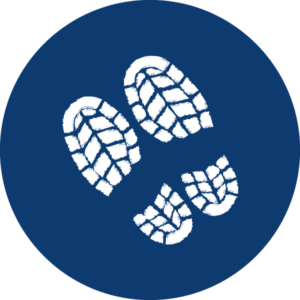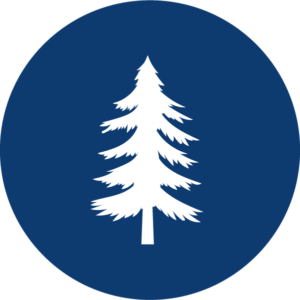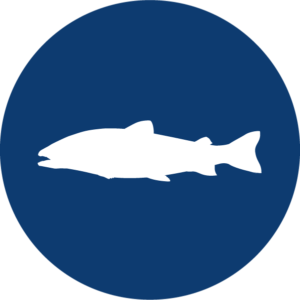 Your Mission…
Your Mission…

Discover the past as you explore the forest and look for the marks of past logging from over 100 years ago! Photograph a springboard notch in an old stump and send it to us! Along the way, you will learn how to identify the five major trees inhabiting the Pacific lowland forests.
McLane Creek Nature Trail is part of the Capitol Forest, owned by Washington State. In the late 1800’s, when Washington became a U.S. state, the early legislators designated Capitol Forest to provide funding for public buildings through managed timber sales. Several decades ago, the state decided to set aside this part of the Capitol Forest to be a recreation trail so that people could enjoy the beaver pond, see chum salmon in the fall, and learn some logging history.
Did you know?
In the early logging days, in order to cut down the tree above the wider root zone, springboards were inserted into the sides of the tree for the loggers to stand on? A number of tree stumps along the forest trail still have the notches left by the springboards. For more info on springboard logging visit: https://www.communitystories.ca/v2/lumbys-pioneers_pionniers-de-lumby/gallery/early-tree-fallers https://timeline.com/logging-photos-of-washington-states-old-growth-forests-bf18aef19955
![]()
 Welcome to McLane Creek Nature Trail
Welcome to McLane Creek Nature Trail
Check out the map at the entrance to the trail. McLane Creek Trail is a big loop trail divided down the middle by a straight trail which historically was part of the railroad track that carried logs to Puget Sound. For today’s forest trail mission, you will hike around the entire outer loop. Start out by walking to the covered picnic tables and then turning left (west) to begin the trail. (When the trail splits, stay to the right.)
 Viewing Decks
Viewing Decks
You will soon come to two viewing decks. Stop to enjoy a view of the beaver pond. For more information about the pond and the wildlife living there, you may enjoy going on McLane Creek Trail’s other mission, “Wetland Walk.” https://streamteam.info/nature-sleuths/mclane-creek-nature-trail/
 Trail Junction
Trail Junction

After passing by the pond, you will soon arrive at the junction of the main outer trail and the straight trail that used to be a railroad track. This junction is surrounded by large red alder trees which are easily identified by their gray, patchy bark and “toothed” leaves. See if you can find any fallen leaves of the red alder trees. Continue straight, do not turn right onto the straight trail.
Red alder trees are one of the first trees to grow back in a forest after a disturbance like a fire or logging operation. They don’t live nearly as long as the other trees, but they do have the ability to take nitrogen from the air and send it down into the soil, helping to restore soil nutrients. The Native Americans used the inner bark of the red alder tree for a red dye.
 Boardwalks
Boardwalks

The next part of the trail includes several boardwalks when traversing wet areas. Some of the areas are so wet during the fall, winter, and spring that they are considered to be wetlands. If you are visiting during the spring and see and/or smell skunk cabbage, you are likely walking over a forested wetland area.
A wetland is land covered by shallow water all or part of the year, with water-loving plants (like skunk cabbage) growing in them. Because the water covering wetlands reduces the oxygen in the soil below, wetland soil is referred to as “hydric” soil and often has a “rotten egg” smell.
Wetlands can be classified as either “marshes” which have mainly grass-like and non-woody plants (like the beaver pond with its cattails and pond lilies), or “forested wetlands” which have mainly trees and shrubs. (Forested wetlands used to be called “swamps.”)
Some trees and shrubs can tolerate wet soils better than others. Willow shrubs, for example, can grow in standing water. Red alders and maples don’t like standing water but can tolerate wet soils. Cedars and hemlocks do well in slightly wet or slightly dry soils, whereas Douglas fir trees are usually found growing in upper areas of dry soil.
 Nearing the McLane Creek Viewing Platform
Nearing the McLane Creek Viewing Platform

You will come to a second junction at which you can either (1) keep walking straight ahead to the creek viewing platform or (2) turn right onto the trail that continues the outer loop. Between this junction and the viewing platform is a stand of Western red cedar trees. They are distinguished by their “shreddy” bark, scaled leaves, and tiny cones. See if you can find any cones on the ground or if you can reach any of the leaves to feel their overlapping structure.
The Western red cedar tree had many uses for Native Americans. Its inner bark was woven into rain capes, hats, and mats. Its wood was carved into boxes and utensils of all kinds. Wooden slabs could be cut for longhouse construction, and cedar logs were carved into canoes.
 McLane Creek Viewing Platform
McLane Creek Viewing Platform
Here you can see the McLane Creek flowing north on its way to Eld Inlet and Puget Sound. From about mid-November to mid-December, you can see chum salmon using the creek for spawning. The females will have a dark band running the length of their sides. You may see and hear a female turn on her side and rhythmically splash her tail to dig out a nest in the streambed gravels. Other splashing may indicate males chasing each other away from the females. Males have the distinctive “rainbow” pattern on their sides. There are a number of educational signs around the platform if you want to learn more about the chum salmon’s journey.
Watch this excellent 13 minute video on Pacific Salmon and their Circle of Life!
Check out the South Sound GREEN program’s McLane Creek Nature Trail Resources, including an interactive Digital Notebook!
Whether or not it is the right time of year for salmon, you can always l see many big leaf maple trees. Big leaf maples, as their name implies, are distinguished by their giant 5-lobed leaves, the moss growing on the bark and the licorice ferns sprouting from the moss. Even in the winter when the leaves are gone, the moss and ferns will be bright green. Can you find any big leaf maple leaves on the ground or see the licorice ferns on their back sprouting from the moss?
Did you know?
The big leaf maple tree of the Pacific Northwest has the largest leaf of any maple tree. The moss was used by Native Americans for diapers and wound dressings, while the licorice ferns were used for medicinal purposes and chewed for the licorice flavor.
 Return to the Outer Loop Trail
Return to the Outer Loop Trail
 Return to the junction and turn left onto the outer loop trail. Along this part of the trail you will see many “nurse stumps.” These are old stumps from Western red cedar trees that were logged many, many years ago. They are called nurse stumps because other plants are growing on the stumps, the rotting wood of which provides nutrients for young plants like red huckleberry, ferns, and Western hemlock trees. Some of these old stumps are HUGE! See if you can estimate how wide some of those old trees were. Imagine how hard it must have been to cut one down without a chain saw!
Return to the junction and turn left onto the outer loop trail. Along this part of the trail you will see many “nurse stumps.” These are old stumps from Western red cedar trees that were logged many, many years ago. They are called nurse stumps because other plants are growing on the stumps, the rotting wood of which provides nutrients for young plants like red huckleberry, ferns, and Western hemlock trees. Some of these old stumps are HUGE! See if you can estimate how wide some of those old trees were. Imagine how hard it must have been to cut one down without a chain saw!
Usually, any tree growing out of a nurse stump will be a Western hemlock which is distinguished by its short, flat, needles and graceful limbs. (It is sometimes called the “ballerina tree.”) See if you can identify a hemlock tree or find its tiny cones on the ground.
FACT! The Western hemlock is Washington’s State tree.
 Third Junction and Logging History Area
Third Junction and Logging History Area
 After passing many old cedar stumps, you will arrive at a third junction where you can either (1) continue straight ahead onto a boardwalk and the outer loop trail, or (2) turn left onto a side trail and an area with signage about the area’s logging history.
After passing many old cedar stumps, you will arrive at a third junction where you can either (1) continue straight ahead onto a boardwalk and the outer loop trail, or (2) turn left onto a side trail and an area with signage about the area’s logging history.
Also, if you turn into the logging history area, you can keep going on this side trail until you come to a bridge over McLane Creek. This is another good viewing spot to see chum salmon in Nov/Dec.
QUESTION: Can you find any trees with exposed, twisted roots? How do you think these trees became this way?
These trees began growing on nurse stumps. Eventually the nurse stumps rotted away, leaving the exposed roots. Sometimes a tree can survive this condition, and sometimes not.
Continuing Down the Side Trail
If you continue down this side trail, you will get to learn about the fifth major tree of our lowland forests, the Douglas fir.
So far, you have learned about four major lowland forest trees: red alder, big leaf maple, Western red cedar, and Western hemlock. On this last section of the trail, you will get to learn about the fifth major tree, Douglas fir, which is distinguished by its thick bark, “bottle brush” needles, and very distinct cones.
The Douglas fir is the major species of interest to the timber industry. It is likely that the logging trucks you see on the road will be hauling Douglas fir logs to a local mill or port. Thousands of logged trees were shipped to San Francisco during the gold rush to provide timber for new towns, mine shafts, and railroad ties. Today, at the Port of Olympia, you can see ships loaded with logs for oversees export. A good place to view this is from West Bay Park’s Rotary Point on West Bay Drive in Olympia.
A Native American myth tells the story of how the Douglas fir cone came to be. The short version is that one day some mice were running from a fox and couldn’t find anywhere to hide. Suddenly they discovered a fir cone on the ground, and they all ran up under the scales to escape the fox. That’s why, even today, we can see the little feet and tails of the mice sticking out of the Douglas fir cones. (The scientific name for the “feet and tails” is “bracts.”)
 Return to Junction and Outer Loop Trail
Return to Junction and Outer Loop Trail
Return to the junction and turn left onto the outer loop trail. For most of this section you will be on a boardwalk, walking through a forested wetland that has experienced a lot of storm damage. Sometimes people see an orange “scum” in the water below this boardwalk and worry that it might be pollution, however, it has been tested often and turns out to be a natural algae.
Can you find and identify the giant hemlock tree?
 Congratulations!
Congratulations!
You have completed your mission to explore the forest and look for the marks of past logging from over 100 years ago! Don’t forget to login to the Goose Chase App and submit your photo for this mission to collect your park specific sticker!
Return to the trail entrance by the covered picnic tables.
